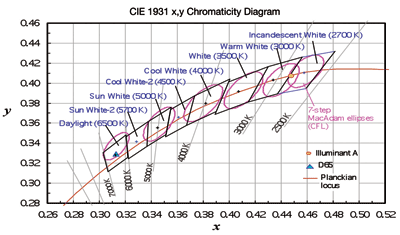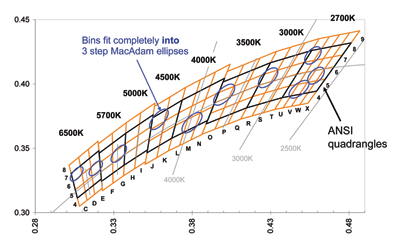Why lifetime color consistency is important for LEDs
Targeting the smallest binning quadrangle is the first step in maintaining lighting consistency over the life of an SSL fixture
BY MICHAEL GODWIN
Director of Visible LEDs
OSRAM Opto Semiconductors
www.osram-os.com
LEDs provide excellent color rendering and uniformity of light, and thereby achieve a high light quality for most lighting applications. LEDs also give designers a whole new palette of color, and, by enabling advanced digital control and the possibility of environmental sensing, deliver a multi-dimensional, interactive experience. With most all LED package options available for all colors, LEDs bring a whole new dimension of possibilities to lighting and design not possible with conventional fluorescent or incandescent lighting.
With expensive durable goods such as automobiles and major appliances, harmonizing the color between many finished products and within several applications of a product is no small task. Understanding how LED color is measured and specified makes this possible.
Binning for color consistency
As semiconductor products, white LEDs are sorted, in a process known as binning, to ensure consistency of color and quantity of light so that designers can specify precisely the color and brightness they need for their particular applications. Targeting the smallest binning quadrangle at the LED initial test point (t0 , or beginning of the life cycle) is a critical requirement to maintaining lighting color consistency in the finished assembled products.
Selecting a realistic shippable bin region that is both economical and consistent for the application requirements can help ensure the design color consistency for the life of a product. Color binning selection is one of the most important decisions designers need to factor into their LED lighting design.
How are bins specified? In 1931, the CIE (Commision Internationale de l’Eclairage , or International Commission on Illumination) established a standard with respect to human color vision (CIE 1931 x,y) that defines the color metrics critical to consistent lighting quality. The standard is rather complicated and involved; for instance, metrics must be measured at a uniform luminance level, because the human eye sensitivity to color is reduced as the brightness of any light source is increased. However, American industry has established its LED color measurement standards based on the CIE 1931 x,y standards metrology (see Fig. 1 ), so it is important to understand the full spectrum of standards for color.

Fig. 1: The American National Standard Institute (ANSI) chromaticity specification defines binning regions (black) based on the CIE 1931 x,y color space. The regions correspond approximately to seven-step MacAdam ellipses (lavender), which define compact fluorescent color space.
Early in 2008, the American National Standard Lighting Group (ANSLG) published “Specifications for the Chromaticity of Solid State Lighting Products” (ANSI_NEMA_ANSLG C78.377-2008). This standard specifies the range of chromaticities recommended for general indoor lighting with LED products, and ensures that the white-light chromaticities of the products can be communicated to users. This standard applies to LED-based SSL products incorporating control electronics and heat sinks.
The pace of change with solid state lighting is rapid, requiring the designer to pay close attention to the initial color and illumination at t0 and final color and illumination at t50K . (The end of the serviceable product life is considered 50,000 hours.) Precisely controlling LEDs with smaller LED color bins can help ensure color consistency in the lighting application (see Fig. 2 ).

Fig. 2: fine binning of white LEDs (orange lines) is segmented to correspond with the ANSI quadrangles (black lines). Each bin fits inside a three-step MacAdam ellipse (blue ovals), representing the limit of color difference that can be perceived by the human eye, to accommodate applications where precise color matching is critical.
Designers should pay special attention to the shippable binning limits of LED suppliers. Although it is technically possible to refine the bin size to very small areas, the manufacturer’s ability of a to consistently ship an ample supply of LEDs from any bin, throughout the product life cycle needs to be considered.
Color life
While the LED industry has advanced its understanding of lumen depreciation, there is still a need to develop a common understanding of the color shift of light sources and systems over time. With pre-defined stress and acceleration factors, LED fixtures can shift in color over time. The high output of phosphor-converted white LEDs based on high energy blue (450 to 470-nm) emitters can degrade plastic materials, causing a long-term color shift in the fixture.
With lighting products, it is important to consider the system degradation modes over the entire product life cycle. It is well understood and documented that the reliability of LEDs far exceeds the reliability of conventional discharge, fluorescent, incandescent, and halogen light sources. This is mostly due to the enhanced robustness of a solid state semiconductor device, which is not subject to the classic infant mortality mechanism of a filament or a glass-seal product.
However, maintaining consistency in color over the usable service life of a product is very important. A commercial lighting installation using LEDs may include tens to hundreds of fixtures with hundreds to thousands of LED emitters, making consistency of color critical to delivering the most consistent appearance and optimum aesthetic appeal over time.
Color consistency is influenced by many factors. It is, of course, linked to the precision of the initial binning, but color can shift over time, depending on such factors as environmental conditions (humidity, ambient temperature), material selection (LED packaging, optic materials), operating current and voltage applied to the LED, and electronic controls and components.

Fig. 3: The fishbone diagram shows the factors that can affect color consistency over time.
To maintain color consistency over the life cycle of a product, lighting designers should continue to evaluate and control the brightness and color at t0 and also understand the interactive effects of materials to maintain consistency through product life cycle. The so-called fishbone reliability diagram (Fig. 3) can be a useful guideline for evaluating potential reliability variables in LED lighting fixture design. Product designers and engineers must consider all interactive elements, such as man, material, machine, process, and environmental factors, and all the potential degradation mechanisms that can occur from the luminaire’s initial t0 to final t50K life expectancy.


Fig. 4: LEDs like the OSLON Black (top) and SSL Series (bottom) are examples of fine white color binned LED packages that have different optical and thermal characteristics suited for various applications.
With proper binning controls, LEDs can provide excellent color consistency and light uniformity. White fine binning is critical to application designs where precise color matching is crucial to the product design and appearance (see Fig. 4 ). Designers should pay close attention to the shippable binning limits of their LED supplier. Ensuring a supply of consistently binned LEDs will also help ensure color consistency over a product’s lifecycle. ■
Advertisement
Learn more about Osram Opto Semiconductors





